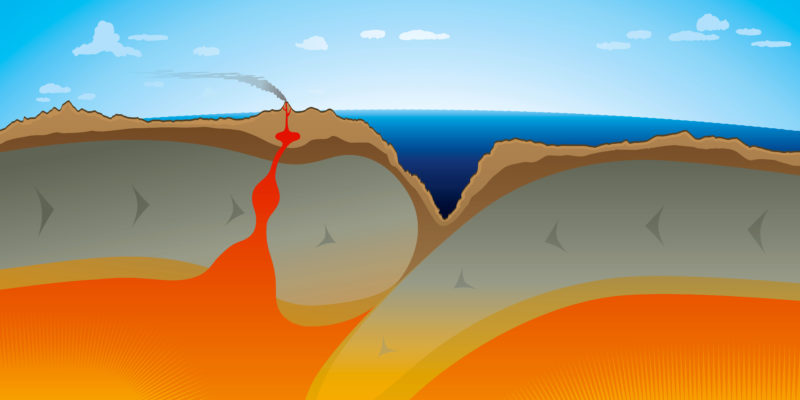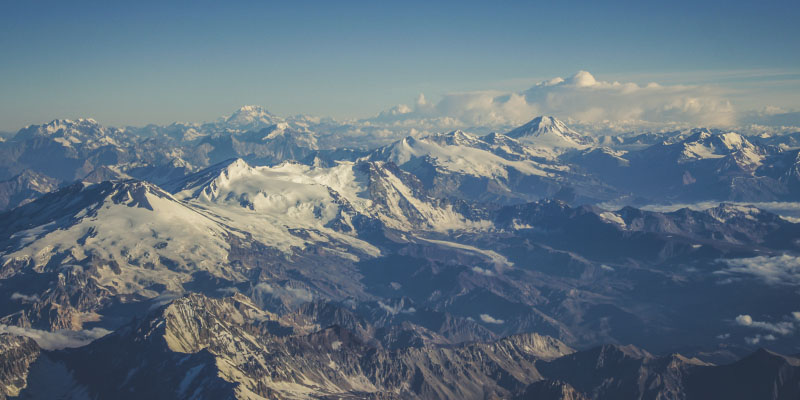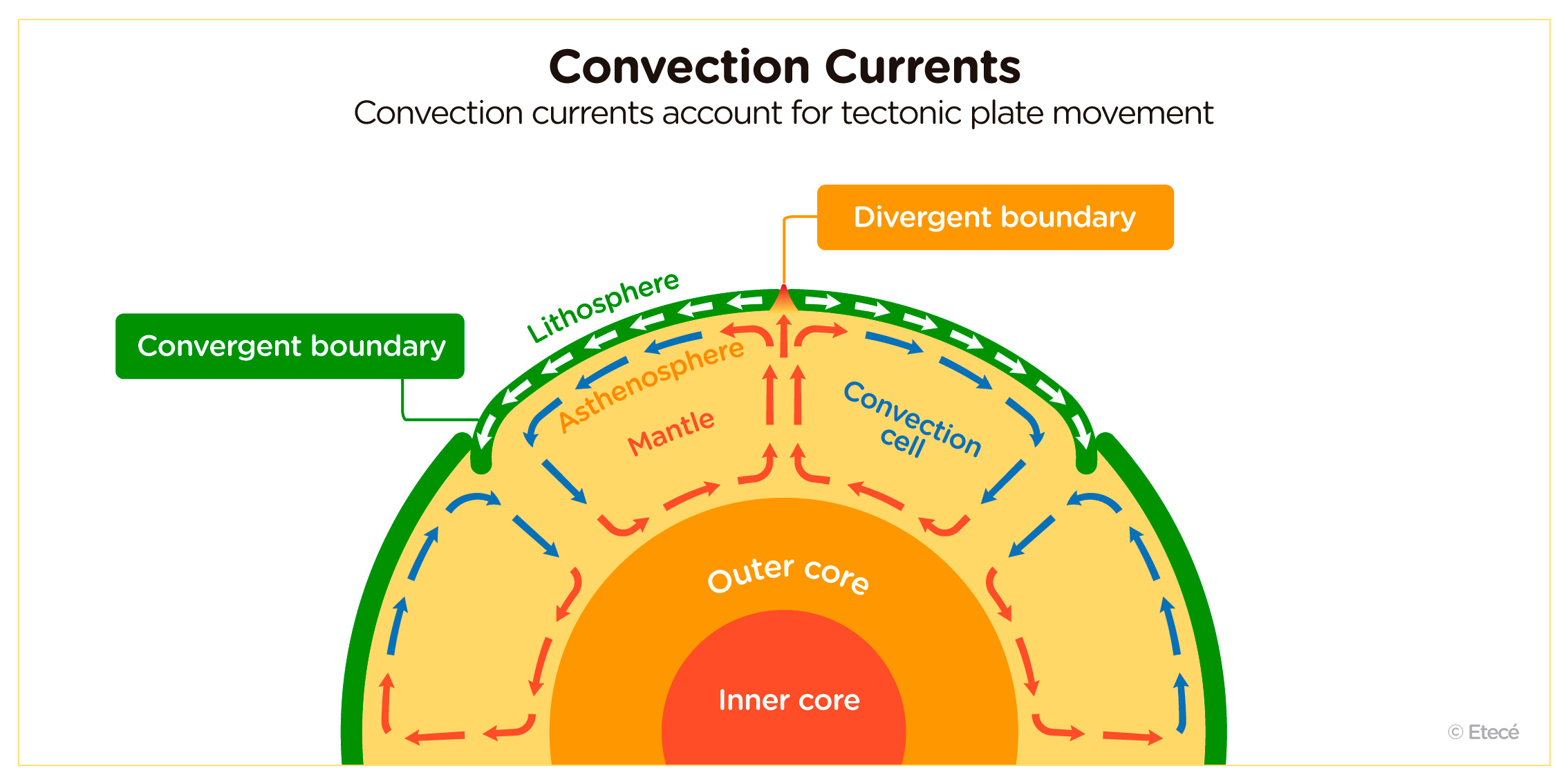We explore tectonic plates, and their importance in shaping Earth’s landforms. In addition, we discuss their characteristics and classification.

What are tectonic plates?
The Earth's outermost layer, called the lithosphere, is made up of solid, rigid rocks and is divided into large slabs known as tectonic plates. Tectonic plates lie on top of the asthenosphere, a layer in the planet’s interior of a more plastic nature and a density between solid and fluid, which allows plates to move and shift in all directions.
The movement of tectonic plates was first explained in the theory of plate tectonics. It is a scientific theory formulated in 1968 which not only elucidates the motion and interaction of the plates, but also accounts for the formation of mountains, volcanoes, and oceans. Furthermore, the theory identifies tectonic plate boundary zones, characterized by important seismic and volcanic activity.
The knowledge of tectonic plates and their dynamics was fundamental to the understanding of continental drift, a concept introduced in 1915 in the Theory of Continental Drift by German meteorologist Alfred Wegener.
- See also: Earthquake
Characteristics of tectonic plates
Tectonic plates share the following characteristics:
- They are large fragments of the lithosphere.
- Their study is encompassed within the theory of plate tectonics.
- Three types of tectonic plates exist: oceanic, continental, and mixed.
- There are fourteen major tectonic plates on the planet.
- Plate motion is accounted for by convective currents of magma in the asthenosphere, the layer of the planet's interior lying beneath the lithosphere.
- Plate boundaries can interact in three different ways: convergent, divergent, and transform boundaries.
- The interaction between plates accounts for Earth's landforms and oceans.
- Plate boundaries cause seismic and volcanic activity.
Types of tectonic plates

While all tectonic plates are rigid and solid, they differ in shape, which is irregular, and thickness, which is variable. Plates do not coincide with the shape of the continents as seen on a map, but rather most plates include oceanic crust and may span more than one continent.
There are three types of tectonic plates according to the type of crust that composes them:
- Oceanic plates. They are made up of oceanic crust and are almost entirely covered by water. For example: the Pacific plate.
- Continental plates. They are made up primarily of continental crust. For example: the Arabian plate.
- Mixed plates. They are made up of both oceanic and continental crust, and are the most common type of plate on Earth. For example: the South American plate.
Major tectonic plates
There are fourteen major tectonic plates:
- African Plate. It includes Africa and the eastern Atlantic Ocean.
- Antarctic Plate. It contains Antarctica and the South Pole.
- Arabian Plate. It includes the Arabian Peninsula and the Middle East.
- Cocos Plate. It is in the Pacific Ocean off the coastal regions of Central America.
- Nazca Plate. It is in the Pacific Ocean off the coasts of Peru, Chile, and Ecuador.
- Caribbean Plate. It is in the Caribbean Sea, north of South America.
- Pacific Plate. It includes most of the Pacific Ocean.
- Eurasian Plate. It contains Europe and most of Asia.
- Philippine Plate. It is in the Pacific Ocean off the coasts of Southeast Asia.
- Indo-Australian Plate. It includes most of Oceania, India, and its surrounding oceans.
- Juan de Fuca Plate. It is off the west coast of the United States.
- North American Plate. It includes North America, Greenland, Iceland, and parts of Russia.
- Scotia Plate. It is in the Atlantic Ocean south of South America and north of Antarctica.
- South American Plate. It contains South America and the adjacent Atlantic Ocean.
Plate boundaries

Interaction between tectonic plates occurs at their boundaries or edges. The boundaries of two adjacent plates can be of three types:
- Divergent boundaries. They occur when two tectonic plates move away from each other. This causes magma to rise from the Earth's interior, which, upon cooling solidifies, creating new crust.
- Convergent boundaries. They occur when two tectonic plates come together and push each other. As a consequence of this interaction, the denser plate slides beneath the less dense one and melts into the mantle beneath the Earth's crust. This creates folds in the crust, leading to the formation of mountain ranges and volcanoes.
- Transform plate boundaries. They occur when two plates move laterally past one another neither creating nor destroying lithosphere.
Consequences of plate motion

It is at plate boundaries that the consequences of plate motion are most strongly evidenced. The main consequences include:
- Volcanic activity. It occurs when magma rises to the surface causing volcanic eruptions. Volcanoes may be found in continental crust (formed by the convergence of plates) or in oceanic crust (formed by the separation of plates).
- Formation of mountain ranges. It occurs at convergent plate boundaries. As a result of the thrust between plates, the less dense plate folds, forming major continental mountain structures.
- Earthquakes. Areas at plate boundaries have a high occurrence of earthquakes due to the large release of energy caused by the motion and interaction between tectonic plates.
The speed of plate motion depends on their size, composition, and interaction with other plates. America and Africa, for example, are moving apart at a speed of about three centimeters per year. To get a sense of the slowness of this motion, if Christopher Columbus were to set off for America in 2023, he would have to sail only 85 feet (26 m) farther than in 1492.
How do tectonic plates move?

The upper layer of the mantle, called the asthenosphere, has a semi-plastic composition since it is made up of magma, whose density is between solid and fluid. Due to its semi-plastic nature, the magma composing the asthenosphere moves through convection currents.
Magma at deeper levels is hotter and has a higher pressure, so it tends to rise toward shallower, less hot areas. As it rises, it pushes down cooler magma particles that are closer to the surface. In turn, as these particles descend, they become hotter, increase in pressure, and rise again.
These continuous currents, called convection currents, are what cause magma to be in constant flow in the asthenosphere. As plates lie on top of the asthenosphere, they move as a result of convection currents.
Explore next:
References
- Gil, A. (2020). El mapa de las placas tectónicas. El Nuevo Orden Mundial. https://elordenmundial.com/
- National Geographic. (s. f.). ¿Qué son las placas tectónicas y qué ocasiona su movimiento?. https://www.nationalgeographic.es/
- Tarbuck, E. y Lutgens, F. (2005). Ciencias de la Tierra. Una introducción a la geología física. Prentice Hall.
Was this information useful to you?
Yes NoThank you for visiting us :)